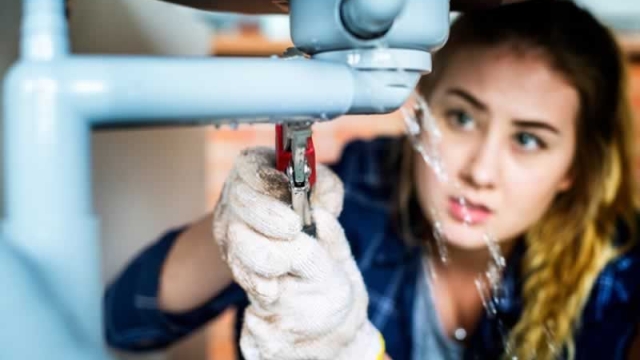Are you tired of dealing with plumbing issues in your home? From acute clogs to faulty heaters, plumbing problems can be a real headache. But fret not! In this article, we will be addressing 10 common plumbing issues and providing handy solutions to fix them. Whether you're a DIY enthusiast or a novice homeowner, these tips will help you navigate through the world of plumbing with ease. So sit back, relax, and let's dive into the wonderful world of pipes and faucets!
1. Acute Clog Solutions
When it comes to dealing with an acute clog, there are a few solutions you can try before calling a professional plumber. First, you can attempt to use a plunger to dislodge the blockage. Simply place the plunger over the drain opening and vigorously push and pull to create suction. This can often be effective in clearing minor clogs.
If the plunger doesn't work, another option is to use a plumbing snake or auger. This tool is designed to break through clogs by either pushing through the obstruction or by hooking onto it and pulling it out. Insert the snake into the drain until you feel resistance, then rotate it in a clockwise direction while pushing forward. With a bit of persistence, this method can often resolve more stubborn clogs.
In some cases, chemical drain cleaners can also be used to dissolve clogs. However, it's important to use these products with caution and strictly follow the instructions provided on the packaging. The chemicals can be harmful if not used properly and may cause damage to your pipes. If you're uncomfortable using chemicals or if the clog persists despite your efforts, it's best to consult a professional plumber to avoid any further issues.
2. Faulty Heater Fixes
If you're faced with a faulty heater, don't panic just yet. There are a few common issues that you can easily fix yourself. Before diving into any repairs, make sure to turn off the power supply to the heater to ensure your safety.
First, check if the pilot light is on. If it's not, relighting it might solve the problem. Locate the gas control valve and turn it to the "off" position. Wait a few minutes, then switch it to the "pilot" position. While holding down the reset button, use a long lighter or match to ignite the pilot light. Once it's lit, hold the reset button for about 30 seconds and then release it. If the pilot light stays on, your heater should start working again.
Another common issue is a faulty thermostat. If you're not getting any heat or the temperature is inconsistent, it's possible that the thermostat is malfunctioning. Start by replacing the batteries in the thermostat, as depleted batteries can cause connectivity issues. If that doesn't solve the problem, you might need to replace the thermostat itself.
Lastly, check the water supply valve leading to the heater. Sometimes, the valve may be partially closed, limiting the flow of hot water. Make sure it's fully open to allow for proper water circulation.
Remember, if these fixes don't work or you're unsure about anything, it's always best to seek professional help. They can diagnose the issue accurately and provide the necessary repairs for a fully functional heater.
This concludes our second section on faulty heater fixes. Stay tuned for the next section on resolving other common plumbing issues.
3. Troubleshooting Other Plumbing Issues
Leaking Faucet: One common plumbing issue that many homeowners encounter is a leaking faucet. This can be a constant annoyance and also lead to water wastage. To fix a leaking faucet, start by turning off the water supply to the affected faucet. Next, remove the handle and check for any worn-out or damaged parts, such as the O-ring or washer. Replace these parts if necessary and reassemble the faucet. Turn on the water supply and check if the leak has been resolved.
Low Water Pressure: If you've noticed a decrease in water pressure throughout your home, there may be an underlying plumbing issue. To troubleshoot low water pressure, start by checking the water pressure in multiple faucets and fixtures. If the problem is isolated to a single fixture, the aerator or the faucet's cartridge may be clogged with debris. Clean or replace these parts to restore normal water flow. If the low water pressure persists throughout your home, it could be a larger issue stemming from the main water line or a faulty pressure regulator. In such cases, it is recommended to contact a professional plumber for further inspection.
Running Toilet: A running toilet is not only annoying but can also waste a substantial amount of water. Fortunately, fixing this issue is often straightforward. Start by taking off the toilet tank lid and check the flapper valve at the bottom of the tank. Ensure that it is properly sealed and not obstructed by any debris. If the flapper is damaged or worn out, it may need to be replaced. Additionally, check the float system and adjust it if necessary to stop the continuous flow of water. Finally, make sure that the chain connecting the flush lever to the flapper is properly adjusted, allowing for smooth operation. Once these adjustments are made, the running toilet should be resolved.
get started

Remember, while these troubleshooting tips may help in resolving some common plumbing issues, it's important to exercise caution and know your limitations. If you're unsure or uncomfortable with performing any plumbing repairs, it is always best to seek the assistance of a qualified professional.

